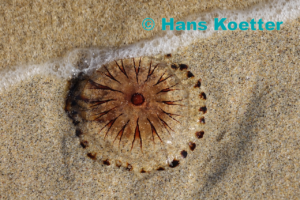Compass Jellyfish (Chrysaora hysoscella)

Compass Jellyfish (Chrysaora hysoscella) - Kompas Kwal
- Taxonomy: The Compass Jellyfish belongs to the Pelagiidae family. Its Latin name is Chrysaora hysoscella. Its common name comes from the compass-like markings on its bell.
- Size: The bell of the Compass Jellyfish can grow up to 30 cm in diameter. It has long tentacles, which can reach 1 meter in length.
- Habitat: This jellyfish is found in the northeast Atlantic, North Sea, and Mediterranean. It often drifts close to shore during the summer.
- Diet: Carnivorous, it feeds on plankton, small fish, and even other jellyfish. The Compass Jellyfish uses its tentacles to sting and capture prey.
- Sting: Its sting can be painful but is rarely dangerous. People should be careful when swimming in areas where these jellyfish are found.
- Coloration: The Compass Jellyfish has a white or pale-yellow bell, marked with brown V-shaped lines. These markings resemble a compass, giving it its name.
- Reproduction: The Compass Jellyfish follows a complex life cycle. It alternates between a polyp and medusa stage, releasing larvae that settle and grow into new jellyfish.
- Ecology: Jellyfish are important predators and prey in marine ecosystems. They help control populations of smaller marine creatures, and in turn, are eaten by sea turtles and some large fish.
Compass Jellyfish: Nature’s Floating Compass
The Compass Jellyfish is a fascinating marine creature. With its striking appearance, it easily catches attention. Its translucent bell has beautiful markings that resemble the points of a compass, hence its name. Found in the waters around Europe, this jellyfish is a common sight during the warmer months. Divers and beachgoers alike may spot it close to the coast.
Not Just a Drifter
Though it may seem like the Compass Jellyfish drifts aimlessly, it plays an important role in its ecosystem. As a carnivore, it hunts small marine animals, using its stinging tentacles to catch food. The tentacles can deliver a painful sting, so swimmers need to be cautious if they see one nearby.
A Closer Look
The Compass Jellyfish may seem simple, but its life cycle is anything but. This jellyfish starts as a tiny polyp, attached to the seafloor. From there, it develops into a fully grown jellyfish, or medusa. As it moves through the water, it feeds on plankton and small fish. In turn, it becomes a meal for larger marine animals, like turtles.
A Delicate Balance
Jellyfish, including the Compass Jellyfish, are part of the delicate balance of the ocean’s ecosystem. They help maintain fish populations by feeding on plankton, and they provide food for larger predators. But changes in the environment, like warming seas and pollution, are affecting jellyfish populations.
Conclusion
The Compass Jellyfish is more than just a beautiful sight in the ocean. It is a key player in marine life, helping to control populations and provide food for other species. Divers and ocean lovers can appreciate its beauty and role in the underwater world. Always remember to admire them from a safe distance to avoid their sting.







